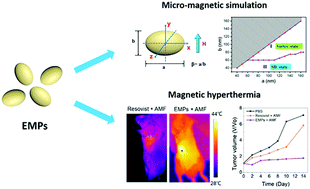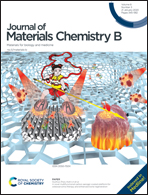Ellipsoidal magnetite nanoparticles: a new member of the magnetic-vortex nanoparticles family for efficient magnetic hyperthermia
Abstract
The development of magnetic iron oxide nanoparticles with novel topological magnetic domain structures, such as the vortex-domain structure, is a promising strategy for improving the application performance of conventional superparamagnetic iron oxides while maintaining their good biocompatibility. Here, we fabricated a new kind of magnetic-vortex nanoparticles, i.e., ellipsoidal magnetite nanoparticles (EMPs), for cancer magnetic hyperthermia. The magnetization configurations and switching behaviours of the EMPs were analyzed by analytical simulations and Lorentz TEM, demonstrating the magnetic vortex structures of both single and coupled EMPs. The EMP treatment of 4T1 cells exposed to an alternating magnetic field (AMF) induced a significant decrease in the cell viability by ∼51.5%, which indicated a much higher cytotoxic effect in comparison with commercial superparamagnetic iron oxides (Resovist, ∼12.0%). In addition, the in vivo high efficacy of 4T1 breast tumor inhibition was also achieved by using EMP-mediated magnetic hyperthermia. Our results not only provide a new type of magnetic-vortex nanoparticles for efficient hyperthermia but also enrich the family of magnetic iron oxide nanoparticles for various biomedical applications.



 Please wait while we load your content...
Please wait while we load your content...